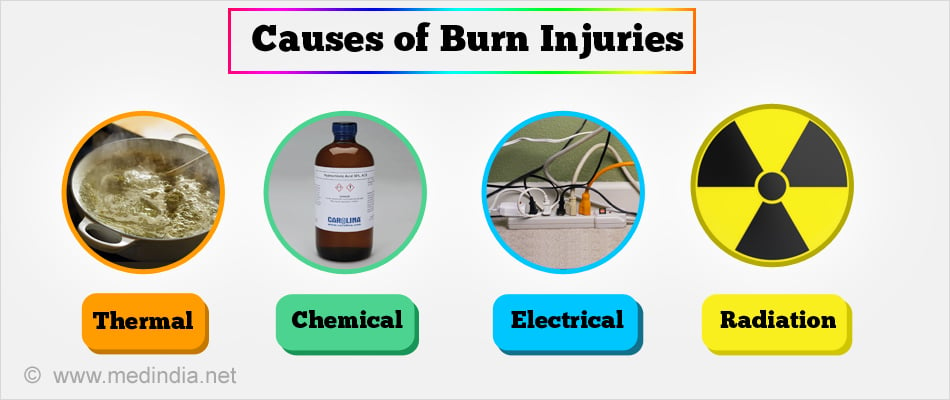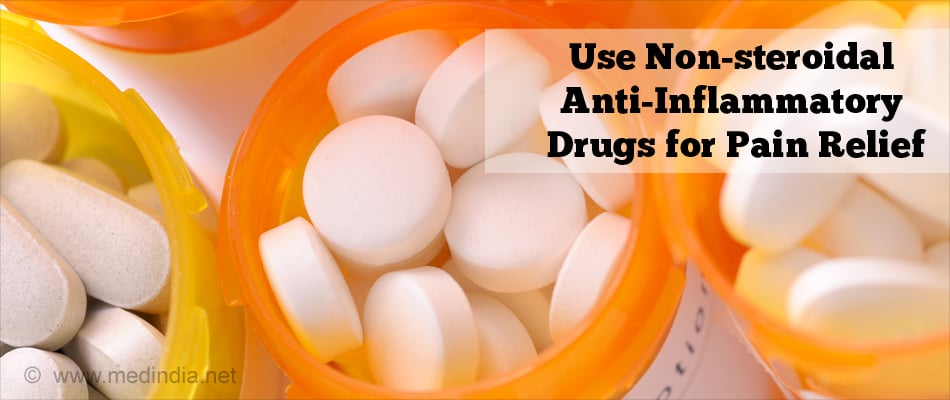- Emergency Burn and Management - (http://michiganburn.org/)
- Managing Pain after Burn Injury - (http://www.msktc.org/burn/factsheets/managing-pain-after-burn-injury)
- Burns - (http://my.clevelandclinic.org/health/articles/burn-pain)
- Antoon AY, Donovan DK. Burn Injuries. In: Behrman RE, Kliegman RM, Jenson HB, eds. Nelson Textbook of Pediatrics. 17th ed. Philadelphia, PA: W.B. Saunders Company; 2004:330-337.
What is Burn Injury Pain?
Pain is one of the most difficult challenges faced by burn patients. Anxiety, disturbed sleep, difficulty in movement, loss of appetite and low quality of life are some of the major consequences of untreated pain. This is true not only for burn patients but for the care givers as well, since it interferes with treatment and healing process. If left unattended, burn pain can lead to depression and result in suicidal tendencies. Poorly controlled pain can further result in post traumatic stress disorder. Pain gets repeatedly inflicted by therapeutic procedures, physiotherapy and other daily activities.
Pain experienced by burn patients is continuous. Its intensity varies. Pain present while the patient is at rest is of low intensity and can last for a longer duration. Intense pain is short-lived and occurs in wound care. There is a spike in pain levels when analgesic efforts are exceeded.
Burn pain requires careful assessment and a multidisciplinary approach that may include both medication and non-medication treatments for management.
Following a burn injury, the patient experiences a very strong sharp pain owing to stimulation of pain sensing nerves termed as skin nociceptors. During the burn injury, if the nerve endings have been completely destroyed, they will not transmit pain. However, when nerve endings are unaffected or when affected nerves regenerate, pain sensation will be triggered.
Increased sensitivity to pain is called hyperalgesia. It can be in a focal point or diffused. Focal hyperalgesia can be classified as:-
Primary hyperalgesia - After a burn injury, the body initiates an inflammatory response which results in the stimulation of pain fibers. This results in increased sensitiveness in the damaged tissues.
Secondary hyperalgesia - Repeated peripheral stimulation of nociceptive afferent fibers results in increased sensitivity in the areas adjacent to the burn wound (surrounding undamaged tissues). In a burn injury, when the damaged nerve endings are exposed to the chemicals released owing to the inflammatory process in the body, namely, bradykinin and histamine, it results in hypersensitivity to non-painful stimuli causing pain. Treatment procedures such as debridement, dressing change, and physiotherapy, also become painful owing to the continuous stimulation of nociceptors.
What is a Burn Injury?
Burn injuries are caused mostly by fire, flammable or hot liquids, heated solids and gases. Exposure to any of these can cause injury to the skin and surrounding tissues that can be of varying degrees of severity.
There are three zones involved in the pathophysiology of burn injuries
- A zone of coagulation of damaged tissue protein in the center of the wound
- A zone of stasis around the coagulation area wherein less of the tissue is damaged
- A zone of hyperemia around the area of stasis that is unburnt but red due to increased blood flow
What are the Causes of Burn Injuries?
Thermal: Thermal wounds (that from fire and hot liquids) contribute to 80% of all burns and are classified according to the depth of the burn. Scalding occurs when there is contact with hot liquids, hot cooking oils, steam and hot objects. Fireworks are also a major cause of thermal burns.
Chemical: Chemicals cause 2 to 11% of all burns; these burns are caused due to contact with strong acids or strong bases.
Electrical: Contact with electrical chords, electrical outlets (mostly in children) and lightning causes electrical burns.
Radiation: Radiations that cause burns are mostly ultraviolet light and ionizing radiation like x-rays.

What are the Types of Burn Injury Pain?
Depth of the burn is a criteria to classify burn injury pain. It is decided based on the number of layers of skin tissue damaged.
The skin consists of three layers:
- The epidermis or the protective outermost layer of the skin
- The dermis (beneath the epidermis) that provides strength and elasticity to the skin
- The hypodermis that lies below the dermis which is made up of fat and connective tissue
On the basis of clinical evaluation of features such as pain, appearance, color, blisters, sensation, and capillary refill, burns can be classified into five categories:
| Degree of Burn | Affected Skin Layer | Appearance | Pain Sensation | Healing time |
| Superficial burns (First Degree) | Epidermis | Superficial reddening of the skin (erythema) but no blisters. | Painful due to the stimulation of nerve endings that remain intact and exposed in these injuries. | One week |
| Superficial partial thickness burns (Second Degree) | Epidermis and superficial dermis | These burns produce blisters and appear pink and wet when debrided. They do not leave a scar. | Painful due to the stimulation of nerve endings that remain intact and exposed in these injuries. | Two weeks |
| Deep partial thickness burns (Second degree) * | Epidermis and deep dermis | Blisters are larger in size. They appear dry, and have fixed blotchy red appearance. | Painful and take longer to heal. In such injuries, some nerves may get completely destroyed. As a result, pain experienced may be less. | Three to eight weeks |
| Full thickness burns (Third Degree) * | Epidermis and entire dermis | These burns have a white or brown leathery appearance and are not painful. | All nerve endings get destroyed leading to no sensation in the damaged area. It causes thrombosis of the blood vessels. | These burns require excision and grafting to allow healing and take a long time to heal. |
| Full-thickness burns (Fourth Degree) | Epidermis, dermis and all the way into underlying fat, muscles and bones. | These burns are black in color. | It causes complete damage to blood vessels and nerves. | These burns can be fatal and scope of recovery in such burns are very less. |
* The surrounding areas of burn wounds maybe painful owing to secondary hyperalgesia.

What is the Diagnosis of Burn Injury?
- Size of the Burn: During burn management, the first step is detailed assessment of burn wound. Size of the burn injury is a very significant factor in planning burn treatment. Damaged area is referred to as the percentage of total body surface area burnt (%TBSA) affected by partial thickness or full thickness burns.
- Severity of the Burn: Pain can be diagnosed according to its severity which in turn is affected by factors like total body surface area burnt, the involvement of specific anatomical zones, the age of the person, and associated injuries.
What are the Phases of Burn Injury Recovery?
While understanding burn pain and planning its treatment, it is important to understand the phases of recovery of a burn patient.
- Emergency phase – Right after the burn injury, the patient requires urgent fluid replacement for stabilization. Post this, the initial wound debridement is done to prevent infection from setting in the burn wound in situ.
- Healing phase – This is a treatment phase requiring regular wound dressings to keep the wound clean, and undergoing surgical intervention to allow healing.

- Rehabilitation phase – The inflammation subsides and scar tissue becomes softer. In this phase, the patient undergoes rehabilitation for months together so as to get back to the normal activities of daily life and release contractures (tightening of the skin due to burn scars).
How do you Clinically Evaluate a Burn Pain?
Intensity - Pain is rated on a scale of 0 -10, with 0 as “no pain” and increasing in ascending order - Duration – It measures how long the pain lasts
- Timing – It marks the periodicity of pain - what activities and what time periods of the day does the pain get worse
- Quality – It defines the nature of pain by the way it feels
- Impact - It measures the level of functionality of the burn patient affected - factors like the ability to do activities of daily life and the emotional outlook of patient
- Itching in the burn wound
How do you Treat Burn Pain?
1. Pharmacological Management
- Non-steroidal anti-inflammatory drugs (NSAIDs) are the preferred line of treatment for long-term pain relief. NSAIDs have analgesic and anti inflammatory properties.

- Paracetamol is the first-line analgesic used in minor and superficial burns. It has analgesic, antipyretic and anti-inflammatory properties.
- Anticonvulsant medications are prescribed for managing neuropathic pain.
- Sleep medications are prescribed if pain interferes with sleep. They are important since more rest helps the healing process.
- Antidepressants are prescribed to beat the stress and anxiety-related depression that the burn patients are expected to suffer owing to continuous pain.
- Preferred opioids are used for short-term analgesic effect of pain due to the dressing:
- Morphine is the most preferred form of opioid with peak analgesic effect of 10–20 minutes after intravenous administration.
- Fentanyl, a potent narcotic analgesic has a duration of analgesia of about 60 minutes.
- Alfentanil is a safer option for change of burn dressings, since it is a short acting opioid (strong analgesia for a short duration of time).
- Remifentanil is a ultrashort-acting opioid for burn dressing change and wound care.
- Methadone, a synthetic opioid provides analgesia and is effective in the management of pediatric burns.
- Ketamine, an adjuvant analgesic, acts both on the central and peripheral nervous system and if used in combination with morphine can provide pain relief.
- Amitriptyline is a tricyclic antidepressant. It has been found effective in managing neuropathic pain.
- Gabapentin has been found effective in reducing hyperalgesia and management of neuropathic pain following burn injury.
2. Non-Pharmacological Approach
Pain cannot be managed only with medications. It needs to be supported with non-medical treatments, which help boost the patient’s morale and ease anxiety and stress caused by continuous pain post burn injury.
- Physical Therapy aims at preventing respiratory complications, controlling edema, maintaining the range of motion of joints, maintaining strength and prevention of scarring.
Techniques used are:
- Body and limb positioning which helps in prevention of contractures.
- Elevation above heart level, is the most effective way to decrease edema.
- Splinting, a device used to stretch contractures through the application of adjusted static force to promote lengthening of contracted tissue.
- Standing/walking support, upper limb and lower limb exercises starting from isometric and progressing to isotonic and iso-kinetic to regain lost muscle strength, lean body mass and endurance. Ergonomic support to help with activities of daily living until normal functionality recovers.
- Manipulative exercises to release contractures.
- Relaxation Therapy - Burn injury results in immense stress on the body owing to the trauma suffered, continuous ongoing pain and the restriction of daily activities. Relaxation interferences like touch therapy, music therapy, and concentration help reduce stress and result in higher vagal flow and lesser activity of sympathetic nervous system.
- Cognitive relaxation therapy includes meditation and cognitive restructuring that help in changing the way the patient looks at his condition, pain, and disability.
- Somatic relaxation techniques use deep breathing, yoga, and progressive muscle relaxation techniques.
- Hypnosis - Hypnotic therapy has proven to be a very effective tool in relieving both acute and chronic pain, since it takes the patient’s mind away from suffering. It is a choice of treatment for psychiatrists in the management of resting pain and excruciating procedural pain. It also helps in improving the body image of the patient and there by speeds up the healing process and patient’s active participation in rehabilitation.

3. Nutrition and Dietary Supplements
A high-calorie, high-protein diet, dietary supplements and drinking 6 to 8 glasses of water daily are recommended for speedy recovery.
- Add foods in the diet that are rich in antioxidants such as blueberries, cherries, tomatoes, bell peppers, and onions.
- Use healthy cooking oils such as olive oil or coconut oil.
- Include supplements like vitamins A, C, E, and B-complex vitamins and essential minerals like magnesium, calcium, zinc, and selenium.
- Consume lean meats, cold-water fish, soy and beans. Include fish and fish oil for omega-3 fatty acids.
- Avoid refined foods like white breads, pastas, and sugar, saturated fats, trans-fatty acids like fried and baked foods, and diuretics like caffeine and alcohol.








